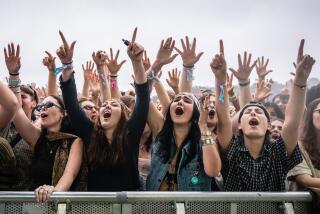Fading Concert Lure at Wild Animal Park Debated by Officials
In their annual year-end exercise, officials at the San Diego Wild Animal Park are again debating the value of the summer music concert series as a way of boosting park attendance.
Park officials say that while the open-air concerts remain popular, they seem to have lost their punch in pulling in new visitors to the animal preserve, located east of Escondido in the San Pasqual Valley.
In past years, the Wild Animal Park has featured local bluegrass groups as well as more recognized pop artists, and has both charged admission to the concerts and offered them for free. Still, attendance at the park continues to drop slightly year after year, and officials are still looking for the right mix to boost attendance.
Among the options being considered is a reduction in the number of free concerts--but featuring better known headliners--or a return to lesser-known, less expensive local groups which might prove more cost-effective in the parkâs ledgers but still attract music fans.
Officials are hoping for the day, said park spokesman Tom Hanscom, when visitors will come to the park solely for the experience of seeing and interacting with the animals, not for side entertainment such as concerts.
But park officials have long acknowledged that since the park is by necessity off the beaten path, it is not the first choice of tourists in San Diego and, in fact, many San Diegans have yet to visit the 1,800-acre preserve.
Thus, a long-standing marketing strategy has been to entice visitors to the park for the first time by offering them something special--a Smothers Brothers or Mamas and Papas concert, for instance--with the hope that those customers will also enjoy the park and return to it, without the lure of a concert.
The concerts began in 1981 âand it looks to us now that weâve skimmed the cream off the topâ of those music fans who also have become Wild Animal Park fans, said Hanscom.
âSo weâre still trying to draw out those folks who still havenât discovered the park and who donât seem to be drawn out by the concerts,â he said.
Attendance at the Wild Animal Park for 1985 will reach about 1.1 million, down about 9% from 1984âs 1.25 million visitors, Hanscom said. Likewise, 1984 attendance was down 15% from 1983âs attendance of 1.46 million visitors.
In fact, the Wild Animal Parkâs only banner year was in 1982--when 10th anniversary promotions at the park attracted more than 1.54 million visitors. That was the only year that the park broke even financially.
The poor attendance in 1984 was blamed on a combination of factors--hot and muggy weather, the distraction of the Summer Olympics in Los Angeles and a $2 per person admission charge for the Wild Animal Parkâs summer concerts over and above the parkâs regular admission charge.
Officials arenât so sure of what to blame for this yearâs falling attendance.
It may be due in part to the fact that there were no full-blown cultural festivals such as the weeklong promotions held in past summers or because some nighttime entertainment was dropped, Hanscom speculated.
A long-range goal of the San Diego Zoological Society, which operates the Wild Animal Park as well as the San Diego Zoo, is for the animal park to make money by 1987.
While the Wild Animal Park has won international acclaim for its success in breeding endangered animals, it is not as popular as the San Diego Zoo among tourists because of its somewhat isolated location and because--given the nature of the sprawling animal enclosures to enhance the breeding program--most animals can be viewed only from a distance while visitors ride a monorail.
To counteract criticism that some visitors leave the Wild Animal Park frustrated that they were unable to see the animals more closely, park officials this year embarked on an ambitious program featuring so-called âinteractive experiences.â
For instance, some animals are taken out of their enclosures and, under the care of keepers, put on display in full, uncaged view at various places in the park, while visitors occasionally are invited to help feed newborns in the parkâs animal nursery.
And, Hanscom said, a new elephant show will soon debut which calls for volunteers from the audience to play tug-of-war with a pachyderm.
âWhile our past elephant show has had a lot of circus behavior, like animals standing on their hind legs or the heads, we now want to better demonstrate their ability and strength,â he said. âIf we can bring a dozen burly guys from the audience into the show ring for some tug-of-war, weâll be having some fun but also demonstrating the incredible strength of the elephant.
âWhat weâre trying to do is bring the animals closer to the people, and to teach the people more about the animals without them realizing it since no one wants education shoved down their throats.â
The Wild Animal Park has had some philosophical problems with its concerts, he said, because of general criticism that such entertainment has no place in a park famous for preserving endangered animals and because the cost of promoting and holding the concerts may not be offset by the increase in attendance.
In addition, Hanscom said, the concerts may have reached a point of diminishing returns since attendance is falling and because live concerts are being held more often elsewhere in San Diego. âThere was a time when we were just about the only game in town, but that isnât the case anymore,â he said.
Park officials are not able to measure accurately how important the concerts are to park attendance because the concerts have been held almost every summer weekend since 1981, so there is no basis by which to compare a summer concert weekend to a summer non-concert weekend.
The closest the park can come is to compare attendance over a three-day weekend last June, when Jim Stafford appeared in concert and attendance was slightly over 20,000 total for the three days, compared to the previous weekend--before the summer concert series began--when attendance was 13,000 for the three days.
All told, the Wild Animal park offered 13 concerts during 1985, featuring the likes of Pat Boone, Donny and Marie Osmond, Jan and Dean, the Lettermen and Fats Domino. Cost of staging the concerts was about $200,000, but since admission to the concerts was free, officials donât know how many persons were attracted to the park by the concerts or whether the shows paid for themselves.
The park has never conducted so-called âexit-pollâ visitor questionnaires to determine on a quantitative basis the most and least popular facilities, events and attractions at the park, Hanscom said.
âBut we have interviewed small groups of visitors at length and found that the new interactive experiences, like allowing visitors to feed apples to the elephants, are getting rave reviews,â he said.
âThe question is, will those kinds of experiences drive people back in six months? We still donât know. And we anticipate losing money next year as well, until weâre through with our capital improvements and people begin to realize they can more closely experience the animals. Thatâs the reason we want them coming here--not to listen to concerts.â
More to Read
Sign up for Essential California
The most important California stories and recommendations in your inbox every morning.
You may occasionally receive promotional content from the Los Angeles Times.










